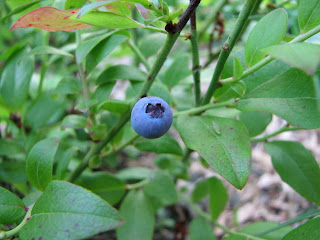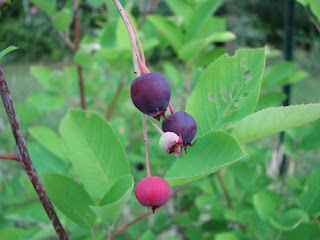Early in the season, we see lots of new vegetative growth in our garden. Leaves emerge and stems elongate as the plants turn simple, abundant resources (sun and water) into energy.
Soon we see flower buds and ultimately, flowers. Lots of flowers. With the flowers we see lots of insects, those that pollinate these plants. Lots of butterflies, bees, and wasps., and other unidentified critters. Also, if you look close at the above flower photo, you'll notice the leaves don't look so hot. Caterpillars and other larvae eat the leaves (in this case, it's a beetle that relies solely on viburnum: the Viburnum Leaf Beetle).
Flowers, of course, are for more than our enjoyment to observe, both by visual beauty and scent. The pollinators are attracted to do a job: transfer pollen to other members of the species to produce fruits. And, ultimately, the plants do produce fruit.
 A surprise: we didn't really expect to get any fruits on our Lowbush Blueberry this year!
A surprise: we didn't really expect to get any fruits on our Lowbush Blueberry this year! Because it's a new to our garden we figured it would take a year for the plant to settle in.
Of course, fruits are more than something tasty to snack on. The fruits are high in lipids (fats), which provide energy to any organism that eats them. We keep this in mind, but mostly we just enjoy the taste of freshly picked blueberries.
 The fruits of Serviceberry, or Shadblow (so named because the flowers emerge when
The fruits of Serviceberry, or Shadblow (so named because the flowers emerge whenthe shad are running). These fruits are among the most sought after berries for birds.
Birds and mammals in particular benefit from these offerings. Birds, for example, need these high-energy foods to gear up for a long migration to their wintering grounds in the southern U.S., Mexico and the Caribbean, or Central and South America.
And herein lies the beauty, the interconnectedness, the spiritualness. The seeds, contained within the fruits, are indigestible, so the animals that ate the fruit essentially plant new seeds when they pass through their digestive system. New plants emerge next year, producing new leaves and stems, and the cycle continues.
The cycle is complete, and upon completion, complete beauty.





No comments:
Post a Comment